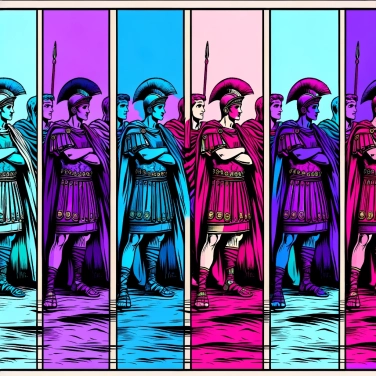The Romans wore tunics dyed in purple because this color was rare and expensive, reserved for the elites and high-ranking members of society. It was a symbol of prestige and power.

The use of purple dates back mainly to the Phoenicians, who settled in present-day Lebanon over 3000 years ago. They produced this vibrant color from a marine mollusk, the murex, by extracting its mucus, which turned a deep violet after being exposed to sunlight. Very quickly, this dye became highly sought after because it was extremely durable over time and maintained its brilliance. Among the Greeks and then the Romans, purple rapidly symbolized wealth, prestige, and power, precisely because it was very rare and expensive to produce. Wearing purple was thus a clear display of one's status and was meant to impress.
The purple dye primarily came from a marine mollusk called murex. It was necessary to collect thousands of these shells to extract a very small amount of dye, which made the substance both rare and expensive. The process required a lot of work: collecting the mollusks, carefully extracting the glands containing the precious liquid, and then exposing everything to the sun to oxidize it and achieve the desired shade. As a result, producing just enough purple to dye a simple tunic would cost a fortune. No wonder only wealthy Romans could afford such a luxury in clothing.
In ancient Rome, the color purple clearly signaled to others, "watch out, I am someone important." Wearing this rare hue was mainly reserved for high dignitaries, victorious generals, and, of course, the emperors themselves. One displayed their power and social prestige through the shade and richness of the garment: the deeper your tunic was dyed in bright purple, the higher you were in the hierarchy. Senators often sported a purple stripe, while emperors sometimes cloaked themselves entirely in this color to remind everyone of their exceptional position. A purple outfit was almost equivalent to flaunting one's rank like an antique Rolex—it was a true visual message, direct and effective in showing who held the authority.
During the Roman Empire, wearing purple was not for everyone. Only members of the imperial family or high-ranking officials were officially allowed to wear this color. Very strict laws limited the use of purple-dyed clothing, sometimes reserving certain shades for the emperor only. If an ordinary citizen dared to defy these rules to show off in purple, it could cost them hefty fines or, worse, severe penalties, even death. Quite a punishment for a fashion choice!
The purple color of the Romans has left a lasting imprint even after the fall of the Empire. For a long time, wearing purple was a symbol of wealth, prestige, and authority. Medieval kings adopted the concept with their royal cloaks, often dyed purple to assert their legitimacy. Even today, the shade of purple is associated with something precious, rare, or noble. It still influences the image of power in art, fashion, and popular culture, a testament to a Roman legacy that remains prominent in the collective imagination.
The Roman Emperor Nero imposed strict restrictions on purple dye, severely punishing those who dared to wear this color without imperial authorization.
The famous purple toga was often more expensive than a solid gold statue, as the manufacturing process was demanding and the raw materials were rare.
In the late Roman Empire, even certain shades of purple were regulated: a shade known as 'Tyrian Purple' was exclusively reserved for the Emperor.
The Romans believed that the color purple reflected the power of the deities, which largely explains why only the dominant elite could wear this symbolic hue.
Yes, archaeological excavations have revealed textile remains dyed with murex purple, thereby confirming ancient historical accounts. Moreover, mosaics, statues, and frescoes regularly depict ruling classes dressed in purple garments, visually attesting to the symbolic use of this color.
The Roman symbolism of purple still influences our society today, as this color remains associated with power, luxury, and wealth. For example, purple clothing or accessories are often linked to notions of prestige or authority, and this color continues to hold symbolic significance in contemporary academic and ecclesiastical traditions.
No, during the Roman Empire, the wearing of purple was strictly regulated by sumptuary laws. Only certain higher social classes, such as senators or the emperor himself, had the legal privilege to wear garments dyed in purple, an exclusive symbol of power and high social authority.
The purple was traditionally worn by Roman emperors, such as Julius Caesar and Augustus, as well as by Roman senators and victorious generals during military triumphs. This color became a direct marker of prestige and political authority.
The purple dye primarily came from a marine mollusk called murex. Its extraction and production required a significant amount of time and raw materials: thousands of shells were needed to dye a single garment, which made this color particularly expensive and accessible only to the Roman elite.

0% of respondents passed this quiz completely!
Question 1/5